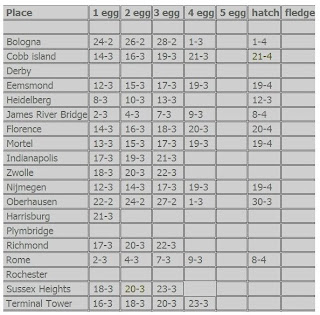
Birds have feathers for insulation — to keep body heat in, and the cold and rain out. They preen the feathers with a special oil from the preening gland just above their tailfeathers. But the same feathers that hold a mother bird's heat in could keep her body's heat away from her eggs and her babies! What can she do to share her body warmth when she's incubating eggs? That is possible with a special adaption: the broodpatch.
The female peregrine, as well as the male develop a brood patch during the breeding season. Changes in hormone levels like prolactine, progesteron and estradiol during the nesting season start the process. These hormones start ro rise as soon as the second last egg has been layed. Down feathers on the bird's tummy, and even some contour feathers, suddenly get very loose. In the peregrine falcon those feathers just fall out. When the feathers fall out, tissue changes start to happen too. The tissue in the tummy area swells. The tissues hold more water, and more bloodvessels are starting to grow in that area. These changes make the bird's tummy skin almost as hot as the body's interior.
When the incubating peregrine sits on the eggs, the skin muscles open up the brood patch. Then the parent sits down and wiggles its body back and forth a bit. The sensitive skin feels for the eggs so the parent can settle where the skin makes best contact with the eggs. The parent keeps turning the eggs almost every hour. This is done to prevent the fast growing enebryo to stick to the shell and to take care the eggs are evenly warmed by the broodpatch!
For the parent peregrine the area of the broodpatch is a problem in their own thermoregulationsystem of the body. In order to keep it's own temperature on 104F they have to eat a lot, so there is a constant suply of energy.
 This tiercel Kaver of Rochester is the resident male of the Kodak Tower eversince 2002 when he replaced Sirocco who did not return after the winter. His partner is the beautiful and exceptional Mariah who is the resident female for 10 years now. Mariah has raised and fledged 38 juvi's !!
This tiercel Kaver of Rochester is the resident male of the Kodak Tower eversince 2002 when he replaced Sirocco who did not return after the winter. His partner is the beautiful and exceptional Mariah who is the resident female for 10 years now. Mariah has raised and fledged 38 juvi's !!












































